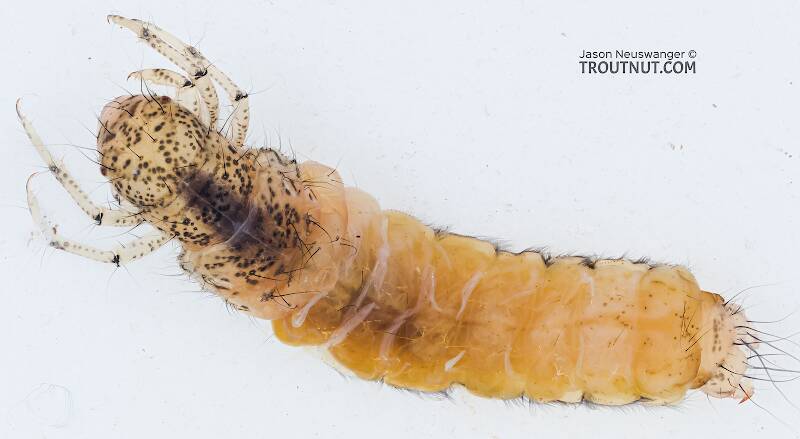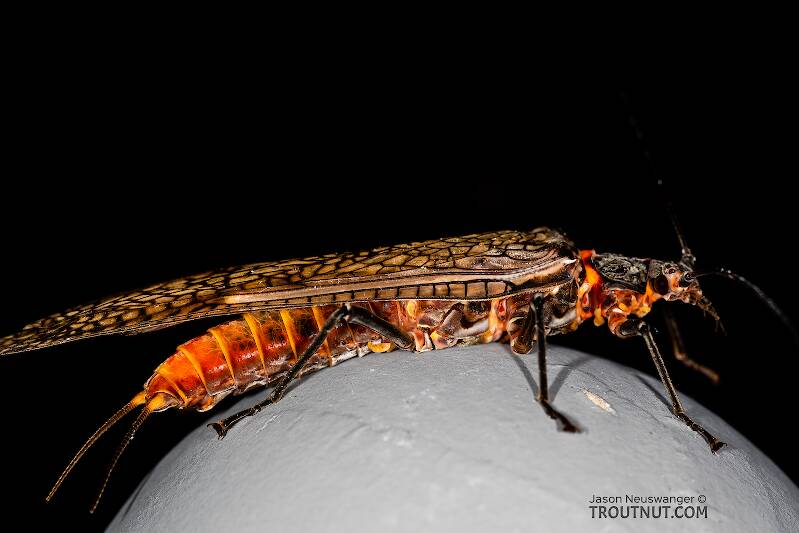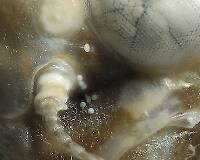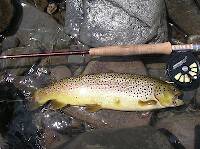
Salmonflies
Pteronarcys californica
The giant Salmonflies of the Western mountains are legendary for their proclivity to elicit consistent dry-fly action and ferocious strikes.
Featured on the forum

This is a striking caddis larva with an interesting color pattern on the head. Here are some characteristics I was able to see under the microscope, but could not easily expose for a picture:
- The prosternal horn is present.
- The mandible is clearly toothed, not formed into a uniform scraper blade.
- The seems to be only 2 major setae on the ventral edge of the hind femur.
- Chloride epithelia seem to be absent from the dorsal side of any abdominal segments.
Based on these characteristics and the ones more easily visible from the pictures, this seems to be Grammotaulius. The key's description of the case is spot-on: "Case cylindrical, made of longitudinally arranged sedge or similar leaves," as is the description of the markings on the head, "Dorsum of head light brownish yellow with numerous discrete, small, dark spots." The spot pattern on the head is a very good match to figure 19.312 of Merritt R.W., Cummins, K.W., and Berg, M.B. (2019). The species ID is based on Grammotaulius betteni being the only species of this genus known in Washington state.
- The prosternal horn is present.
- The mandible is clearly toothed, not formed into a uniform scraper blade.
- The seems to be only 2 major setae on the ventral edge of the hind femur.
- Chloride epithelia seem to be absent from the dorsal side of any abdominal segments.
Based on these characteristics and the ones more easily visible from the pictures, this seems to be Grammotaulius. The key's description of the case is spot-on: "Case cylindrical, made of longitudinally arranged sedge or similar leaves," as is the description of the markings on the head, "Dorsum of head light brownish yellow with numerous discrete, small, dark spots." The spot pattern on the head is a very good match to figure 19.312 of Merritt R.W., Cummins, K.W., and Berg, M.B. (2019). The species ID is based on Grammotaulius betteni being the only species of this genus known in Washington state.

Troutnut is a project started in 2003 by salmonid ecologist Jason "Troutnut" Neuswanger to help anglers and
fly tyers unabashedly embrace the entomological side of the sport. Learn more about Troutnut or
support the project for an enhanced experience here.
This topic is about the Stonefly Species Pteronarcys californica
This is the West's most legendary hatch. Anglers from all over the world make pilgrimages to the region's rivers in the hope of catching large trout surface feeding on these giant insects. Those fortunate enough to hit it right will have an awe-inspiring experience, regardless of their fishing luck.In cycles of plenty their numbers are truly astounding. They make up a large percentage of the biomass and this large lumbering grazer has had its niche likened to the huge herds of bison that once roamed the plains and foothills their rivers flow through. The hatch progresses upriver quickly, with adults being in the air or on the water for a given stretch only a few days or so. For reasons not fully understood, the nymphs prefer certain locations over others for "staging" prior to the hatch. An angler can stand on shore and notice very few of them while 50 yards up or down the rocks and bushes can be crawling. Competent guides and astute locals are aware of these locations and often fish them "in front of the hatch" for spectacular nymph fishing. An added bonus is they are also "in front of the crowds." Visiting anglers would do well to fish upriver of the latest angling reports. Fishing water based on "yesterday's news" often leads to seeing more anglers than salmonflies.
Example specimens
Dbar on Apr 13, 2007April 13th, 2007, 7:16 am EDT
The hatch often occurs during high water (just after peak) so you sometimes have limited visibility during the hatch. Also - I believe that they can occur above 7000 feet.
Love ths site.
Love ths site.
DB
Martinlf on Apr 16, 2007April 16th, 2007, 1:36 am EDT
Another slant, but does higher water have any effect on mayfly and caddis hatches?
"He spread them a yard and a half. 'And every one that got away is this big.'"
--Fred Chappell
--Fred Chappell
Beachvid on Apr 16, 2007April 16th, 2007, 5:17 am EDT
I usually fish 2 or 3 months a year out West and have been lucky enough to fish salmonfly hatches several times. I say lucky because you could go to a specific location or stream and miss the hatch even though you tried to time it perfectly. As mentioned by Troutnut, they do move upstream depending on the grade of the slope or decent of the stream. The hatch can last a while on larger rivers but not in any one area. The hatch time depends on the basic elevation of the stream. The hatch occurs in lower elevation streams earlier and higher elevation stream such as in the high Rocky Mountains later in the year. In the West Yellowstone area, the Madison will start in the canyon below Ennis and move upstream to below Hebgen usually in the last of June to the first couple of weeks in July. Runoff has usually already happened. As with most other hatches, this would occur later than it does in Oregon and Washington.
It is a very confusing hatch for many. When anglers first start seeing the huge flies, they tend to tie on a dry imitation without any luck. Nymph fishing is the key since all stoneflies crawl to the banks and boulders to hatch. You can actually see them early in the mornings along the banks in the water and where they are crawling out of the water or the shucks where they have hatched. Soon after the hatch starts you will begin to see them in the air,bushes, rocks, etc and even on your body. For the first few days after the hatch (two or three) you can beat your brains out casting a dry without any action. When they start the egg laying process, things change 100% and this last a few days (two or three) and fishing can be great. I am describing an area of a river, not the entire river because this entire process is moving up stream as much as 3 to 5 miles a day depending on the stream.
The fish can actually become gorged. I may not have spelling gorged right so full may be a better word. You will notice this is you start seeing them just knock the dry fly around without eating it. In many places, before the hatch ends, it can become compounded with Golden Stoneflies that also start to hatch. This greatly depends on the stream but I have seen it many times.
If you get out to West Yellowstone the first week of July, you will most likely find them somewhere on the Madison somewhere between Quake Lake and Ennis. You have to adjust to the stage of the hatch by fishing a nymph or dry and move around a lot. The drift boat helps because you can cover a lot of water. If you wade or fish the banks, try several areas. There are 4 fly shops in town. Any of them will tell you where the stonefly hatch is happening.
I have a new DVD coming out this month that has about 25 minutes of it devoted to the salmonfly hatch. It includes segments on stoneflies from all nine families and was shot from coast to coast.
I hope all of you experience it one day. Our Eastern Giants hatch and deposit their eggs at night for the most part. I have never found them to hatch in large quanities approaching the salmonflies.
I could go on forever but I suppose the strange thing about it is that the insects are so plentiful and so large, that in a prime habitat, they can fill the trout to the point they are difficult to catch. But don't panic, like many anglers, just move upstream (or downstream if the flies have hatch but not yet deposited their eggs). It is possible to catch several large trout in a few hours while they in the process of hatching or depositing their eggs. In the right spot at the right time, it can very exciting.
Hope this helps those who haven't been there and done it.
It is a very confusing hatch for many. When anglers first start seeing the huge flies, they tend to tie on a dry imitation without any luck. Nymph fishing is the key since all stoneflies crawl to the banks and boulders to hatch. You can actually see them early in the mornings along the banks in the water and where they are crawling out of the water or the shucks where they have hatched. Soon after the hatch starts you will begin to see them in the air,bushes, rocks, etc and even on your body. For the first few days after the hatch (two or three) you can beat your brains out casting a dry without any action. When they start the egg laying process, things change 100% and this last a few days (two or three) and fishing can be great. I am describing an area of a river, not the entire river because this entire process is moving up stream as much as 3 to 5 miles a day depending on the stream.
The fish can actually become gorged. I may not have spelling gorged right so full may be a better word. You will notice this is you start seeing them just knock the dry fly around without eating it. In many places, before the hatch ends, it can become compounded with Golden Stoneflies that also start to hatch. This greatly depends on the stream but I have seen it many times.
If you get out to West Yellowstone the first week of July, you will most likely find them somewhere on the Madison somewhere between Quake Lake and Ennis. You have to adjust to the stage of the hatch by fishing a nymph or dry and move around a lot. The drift boat helps because you can cover a lot of water. If you wade or fish the banks, try several areas. There are 4 fly shops in town. Any of them will tell you where the stonefly hatch is happening.
I have a new DVD coming out this month that has about 25 minutes of it devoted to the salmonfly hatch. It includes segments on stoneflies from all nine families and was shot from coast to coast.
I hope all of you experience it one day. Our Eastern Giants hatch and deposit their eggs at night for the most part. I have never found them to hatch in large quanities approaching the salmonflies.
I could go on forever but I suppose the strange thing about it is that the insects are so plentiful and so large, that in a prime habitat, they can fill the trout to the point they are difficult to catch. But don't panic, like many anglers, just move upstream (or downstream if the flies have hatch but not yet deposited their eggs). It is possible to catch several large trout in a few hours while they in the process of hatching or depositing their eggs. In the right spot at the right time, it can very exciting.
Hope this helps those who haven't been there and done it.
VideoNut
Beachvid on Apr 16, 2007April 16th, 2007, 5:52 am EDT
My wife just happened to nose in and read my previous post. She beat me over the head with a magazine. I type as I think and never edit anything but I think I may have set a record for errors. No, I can't spell but I can do better than that. Hope you can make it out. Please excuse me.
I also wanted to say that I have found the salmonflies many other places other than the Madison. One great place where the hatch usually occurs much earlier is the lower Henry Fork below the dam at Aston. This is a sleeper area anyway. The box canyon upstream above the Ranch usually has a lot of them. There are also hatches inside the Yellowstone Park. The Gallatin canyon is a good place. This usually happens in June. Late June and early July in the Gardner you will find them, usually along with the goldens. There are other hatches in the park. Of course, there are many other good streams with salmonfly hatches all over the West I just wanted to provide some specific locations you can count on.
I also wanted to say that I have found the salmonflies many other places other than the Madison. One great place where the hatch usually occurs much earlier is the lower Henry Fork below the dam at Aston. This is a sleeper area anyway. The box canyon upstream above the Ranch usually has a lot of them. There are also hatches inside the Yellowstone Park. The Gallatin canyon is a good place. This usually happens in June. Late June and early July in the Gardner you will find them, usually along with the goldens. There are other hatches in the park. Of course, there are many other good streams with salmonfly hatches all over the West I just wanted to provide some specific locations you can count on.
VideoNut
GONZO on Apr 16, 2007April 16th, 2007, 6:01 pm EDT
She beat me over the head with a magazine.
Beachvid, your wife sounds a lot like mine. Except she usually gives me the "bad puppy" smack for just being a general dope, not so much for my spelling. :) And thanks for the great summary of the Western stonefly activity.
does higher water have any effect on mayfly and caddisfly hatches?
Short of flooding, Louis, I haven't noticed any significant effects. Though the unusually cold temperatures will slow things down.
Riverratben on Apr 20, 2007April 20th, 2007, 3:30 pm EDT
I have guided the Gunnison Gorge for the last few years. It has the most prolific pteronarcys hatch that I have ever seen, they are crawling up your pants, in your hair, I randomly find them in my house they love to hitch hike. Two years ago the emergence happened on June 7th (low water 500 cfs), last year we had fairly high water (900 cfs) and the emergence happened on June 10th. Keep in mind that this is a tail water fishery not seriously affected by runoff. I don't know what will happen this year but I am expecting a hatch of fisherman larger than that of the pteronarcys due to the movie "The Hatch". I do not think the movie did anything good for the particular fishery but I don't hate these guys for making it. It is one of the best fishing videos I have ever seen. I could not sleep that night, all I wanted to do was fish! If you haven't seen it it is worth the 20 bucks, CHECK IT OUT!
All hatches are later at higher altitudes it seems like but I believe the explanation for that is water temperature and dew point. Every time I hit the emergence of any stonefly hatch there is a high dew point the night of. Coincedense? I havent proven my self wrong yet.
One trick to the stonefly hatch on high pressure rivers is to tie a size 16 curved hook "Leg Egg". Spin black rubber legs around the shank like you would with deer hair then trim them in the shape of an egg sack. Trail this hook 6 inches behind the female pteronarcys pattern when they start laying eggs. Fish do eat the egg sack. My Theory: the egg sack has more nutrition for the fish than the actual stonefly does. You will hook fish for one of 3 reasons using this technique.
1. they think it is the egg sack
2. they will come up and nip the actual stone due to being "stung" a few times, when they nip the dry you will hook them with the egg sack. 3. The guide knows your skill level and figures you need all the help you can get.
This is our little secret! I have only told a few people this so keep it to yourself but try it out.
All hatches are later at higher altitudes it seems like but I believe the explanation for that is water temperature and dew point. Every time I hit the emergence of any stonefly hatch there is a high dew point the night of. Coincedense? I havent proven my self wrong yet.
One trick to the stonefly hatch on high pressure rivers is to tie a size 16 curved hook "Leg Egg". Spin black rubber legs around the shank like you would with deer hair then trim them in the shape of an egg sack. Trail this hook 6 inches behind the female pteronarcys pattern when they start laying eggs. Fish do eat the egg sack. My Theory: the egg sack has more nutrition for the fish than the actual stonefly does. You will hook fish for one of 3 reasons using this technique.
1. they think it is the egg sack
2. they will come up and nip the actual stone due to being "stung" a few times, when they nip the dry you will hook them with the egg sack. 3. The guide knows your skill level and figures you need all the help you can get.
This is our little secret! I have only told a few people this so keep it to yourself but try it out.
SEVERELY ADDICTED!
Frank970 on Aug 20, 2012August 20th, 2012, 1:22 pm EDT
I consistantly catch fish with giant stone nymph patters well about 10000ft.
Sayfu
Posts: 560
Posts: 560
Sayfu on Aug 21, 2012August 21st, 2012, 6:09 am EDT
A lot of female Pteronarcys, most of them, lay their eggs while above the water yet patterns are tied with a black egg sac dubbed at abdomen end. And for the Henry's Fork comment. They move up the NF very quickly, and into the Box Canyon far above,(late May) BUT, there is a later hatch down river I'd say 5 miles below the Ashton Dam at the Fun Farm above St. Anthony due to the colder water coming in from the Fall River at Chester Backwater, and the hatch occurs along that bank only...as much as a 2-3 weeks later.
Ricofreako
Posts: 1
Posts: 1
Ricofreako on Jun 11, 2017June 11th, 2017, 3:39 am EDT
They most definitely occur above 7000'. 6/5/17 I took a day to explore the cobbles near the river bank during high run off to see what was in stock for the trout. I live just shy of 9000', and to my surprise after reading Schwiebert, who said they often do not hatch above 7000', I found quite a few salmon flies in my local water.
Quick Reply
Related Discussions
Topic
Replies
Last Reply
I agree with the nymph and emergence coments above
In the Mayfly Species Litobrancha recurvata by Beardius
In the Mayfly Species Litobrancha recurvata by Beardius
0
Aug 1, 2008
by Beardius
by Beardius
3
Mar 22, 2010
by Motrout
by Motrout
3
Jul 24, 2007
by Wiflyfisher
by Wiflyfisher







